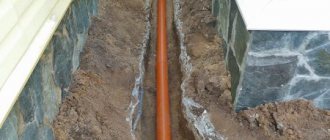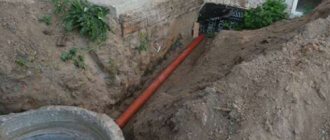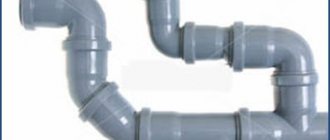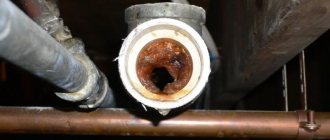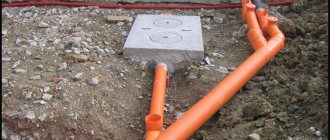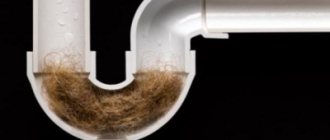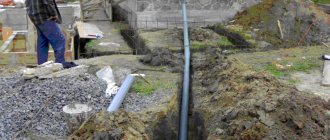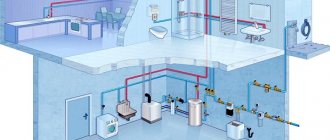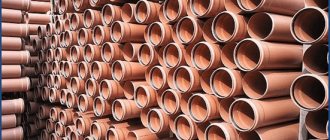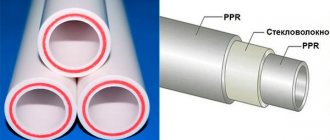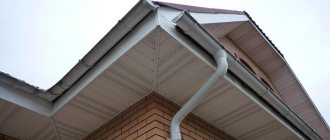You are here: How to install fasteners for sewer pipes?
Previously, sewerage and pipelines were not so often found in private country houses, but today, on the contrary, these communications are necessary for a comfortable stay and recreation even outside the metropolis. Therefore, for modern owners planning to build a private house, the question of proper sewerage installation is a question. In order to install fasteners for sewer pipes, you must strictly follow certain simple rules, which depend on the types of fasteners used in arranging the drainage system.
Types of clamps for fastening sewer pipes
The sections of sewerage pipes are secured to each other using clamps, that is, the fixation is done by grasping the product. The entire structure of such fastening of sewer pipes, in addition to the clasping element, also consists of an anchor or dowel device with which the clamp is attached to a supporting structure, for example, to a wall. Therefore, for such work, you may need a drill or hammer drill, as well as wrenches and screwdrivers to tighten nuts, bolts and screws.
Types of clamps for fastening to the wall
All clamps are divided into several types.
One of the characteristics that allows us to classify plumbing clamps is the material used for manufacturing:
- Metal
. Metal clamps allow for the most rigid and powerful fastening. - Plastic
. Plastic clamps can not only secure the pipe tightly, but also provide a movable connection. Such clamps are practical and low cost.
Another feature that divides clamps into types is the type of fastening.
There are two types of fastenings:
- Hard. Such fasteners for sewer pipes completely block their movement. As a rule, a rigid connection is used in cases where the pipeline must be fixed motionless, for which clamps are attached below the socket at a point as close as possible to it. The rigid support of the fastening in this case is the fitting and its group.
- Floating. For such fastening, you can use the same clamps, but they should not be tightened completely so that the pipe can move inside the connection. This design is possible if the internal cross-section of the clamp is slightly larger than the external diameter of the pipe being secured.
Metal and plastic clamps
A clamp for a sewer pipe can be made of either plastic or metal (for more details: “Which metal clamp to choose for fastening pipes and how to use it”). Both versions of these products are widely used in plumbing work, and their installation is not difficult.
Moreover, many manufacturers produce sewer pipes that are already equipped with all the necessary fasteners (couplings), angles, bends and other parts. This greatly simplifies the process of purchasing components for installing home sewage systems for consumers.
It is worth noting that when choosing what material the sewer pipe clamp will be made from, it is worth taking into account the location of such communications. In particular, this applies to those systems that will not be hidden behind wall panels or other interior elements. In this case, plastic products will look more inconspicuous, although the sewerage system itself is usually not on public display and is located in places where it will not be visible to anyone.
However, in most cases, the process of selecting sewer pipe fastenings is still based on slightly different factors. In particular, the type of fixation may matter, that is, fixed (fixed) or free (floating).
Types of fastenings for sewerage
Safety clamp for sewer plugs
When carrying out plumbing work, the following types of fasteners are used to secure sewer networks:
- Crimping. They can be secured and crimped at the junctions of pipe sections and fitting elements to increase the tightness of the joints.
- Guides. Used when positioning the sewer pipeline relative to the supporting base. These are more markers than mounting parts.
- Supporting. Needed to secure the line to the wall. Such fixing parts are equipped with rubber gaskets that compensate for vibration and linear deformation.
- Safety. Installed in difficult areas that require additional fixation.
Fire protection clamps are also produced. They are used if the riser and the pipeline itself are made of polymer materials. In the event of a fire, such a coupling will prevent the spread of fire and smoke along the main line or through an opening in the slab.
The fixing elements are made of steel and plastic. Both types are quite simple and convenient to install.
When choosing which clamps to purchase - plastic or metal - pay attention to the aesthetics of the room where the sewer pipeline will be located. This is important if it is carried out openly and is not hidden inside interior structures or walls. PVC fasteners are visually more attractive and less noticeable.
Products made of steel with a rubber seal have greater rigidity, so they are used to secure heavy highways. The gasket installed in them ensures a soft, tight connection and protects the pipeline from premature wear at the fastening points.
Polymer products are not suitable if:
- Heavy cast iron pipes are installed;
- additional equipment is installed on the highway;
- the sewer pipeline is operated under vibration conditions.
The clamp for fastening cast iron sewer pipes should only be metal. Depending on the cross-section of the highway, different types of fasteners are selected. After all, the larger the diameter, the heavier the pipe. For sections with a cross-section of 50 mm, heavy-duty products are suitable, and for 110 mm, super-heavy-duty clamps are chosen. The fasteners are made of steel strip with a galvanic zinc coating.
The design characteristics of clamp holders are standard and must meet all the parameters specified in GOST. Each manufacturer must indicate standard dimensions not only in the quality certificate, but also on the surface of the fastener.
Rigid or floating fixation
Please note that there can be two ways to secure a sewer pipe with a clamp: screw the fastener tightly and make it absolutely motionless; leave the screws slightly undertightened to compensate for the thermal expansion of the pipes - this type of fastening is called floating. In this case, you can use the same clamps.
At the same time, there are types of fasteners on sale that are only suitable for free, floating type of installation. As a rule, such products do not have tightening bolts. However, they are attached much easier - with latches, so no special devices are needed for their installation.
The design of the clamps must have special gaskets. They are placed between the pipe and the clamping part of the clamp. The main task of such a gasket is to absorb noise resulting from the load on the sewer pipe and vibration from the movement of wastewater.
Having understood the types of fasteners and the main materials for clamps, we present several main rules that are relevant when installing fasteners on sewer pipes.
Types of pipe fasteners
Today on the construction market you can find various materials for fastening sewer pipes. When creating a sewerage system, clamps, brackets, clips and hook hangers are used. Each mount has its own purpose. Suspensions are used only for fixing pipes to the ceiling, brackets only to the wall surface, the remaining parts can be used to create both ceiling and wall fixations: vertical and horizontal.
Most often, the choice in favor of one or another fastening is related to the pipe material used: polystyrene clips are used for small plastic pipes, and brackets are used for metal-plastic pipes.
We recommend that you read: Repair and replacement of damaged sections of polypropylene pipes
The most popular fastenings for sewerage are clamps of various types. They can be either metal or plastic. Both types allow you to securely fix the pipes at the desired angle. The choice most often depends on the preferences of the buyer.
Note! Metal products are more durable, but are more often used for installing the system in utility rooms or basements due to their less presentability. Plastic products look more aesthetically pleasing and are not subject to corrosion, which is especially important in conditions of high humidity in sanitary premises.
Hanging hooks
This type of fastener is used to hang pipes from the ceiling. This method of fastening is used when laying, for example, sewer hoses in the basement at a short distance from the ceiling.
Brackets
Suitable for fixing metal-plastic pipes. In its design, the part has a metal fastener. In the working position, they prevent the risk of the pipe moving to the sides.
Attention! When using brackets, there must be a distance of at least 5 mm between the pipe and the wall.
Clips
Clips are designed for fixing plastic pipes of small diameter (up to 50 mm). Made from polystyrene. They are easy to use: the clip is fixed to the wall with a dowel, after which the pipe is inserted into it.
Note! Plastic clips are rarely used for installation of sewer systems. More often they can be seen when installing plumbing or heating. The special design of the clip allows you to securely connect the system elements.
Clamps and their varieties
The main fastening parts of the sewer system are clamps. The mechanism of action of the fastener is that the device covers the pipe and holds it in the desired position. Additional elements fix the clamp, and with it the pipe, to the wall surface. The parts can be equipped with rubber inserts that provide reliable grip of the pipe.
A standard clamp in its design has two brackets fastened together with a bolted connection.
We recommend that you read: Modern types of chimney systems
When choosing products, it is important to pay attention to the method of fixation. You can achieve perfect tightness of the sewer system using clamps that provide rigid or floating fastening:
- In the first case, the fixation is a strong fastening that prevents even slight displacement of the pipes. In this case, the pipe is tightened completely.
- Floating connection - involves slight mobility along the horizontal plane, which is achieved by slightly loosening the clamp. This method of fastening eliminates the risk of structural failure due to thermal deformation. They are easy to install: just place the pipe in a clamp mounted on the wall, applying a little force. A small click and the pipe is securely fixed.
Note! The most popular clamps are for floating connections, although parts for rigid connections can also be used for the floating method, just loosen the tension on the pipe and do not tighten the clamp completely.
Most often, classification involves division by materials of manufacture. The choice of a product from a certain material is also associated with the method of fixation. If metal clamps can be used in both options, then plastic clamps are used only for floating mounts.
The main advantage of clamps is the ability to use pipes of various diameters for installation.
Requirements for installation of fasteners on sewer pipes
In order for the pipeline to be laid efficiently, a number of rules must be followed. Strict adherence to the standards will protect the sewer system from many deforming factors, such as high pressure, vibration, the risk of corrosion processes and clogging, to which various structural elements of the pipeline are more or less exposed.
First, you need to monitor the placement of fasteners. It is extremely important to calculate the location of all clamps. They will be required in those places where the sewer system will have bends, branches, fixation of fittings and pipe joints. To get the correct calculations, you need to make a general layout of sewer pipes in advance. It can be in the form of marking center lines on the walls.
Next, you need to take into account the slope of the pipes. Brackets for sewer pipes must be fixed so that the minimum angle of inclination of the pipes is at least 20 mm per meter of the pipeline system (pro
Why do you need to fix sewer pipes?
Correct and reliable operation of the sewer system depends on many aspects: the correct choice and proper quality of materials, error-free installation and fixation of the pipeline.
On the one hand, reliable fastening of the sewer pipeline to the wall helps to facilitate the installation of the system, and on the other hand, it reliably fixes the pipes and eliminates sagging and excessive movement of the pipe under the influence of the movement of wastewater. This is especially important at joints. If the pipe is not securely fastened, the connections will quickly become loose and, over time, lose their tightness. The smell from sewage, as well as liquid waste, penetrates outside and seriously poisons the lives of people in the room where the sewer pipe is leaking.
Attention! When installing a sewer system, it is necessary to pay attention to the quality of materials. In order for the system to work for a long time and be reliable, it is important to use high-quality fasteners.
Technical characteristics of plastic clamps
Plastic options are inferior in strength to steel ones, but have increased elasticity and the ability to withstand high vibration. Suitable for creating movable supports, can be used to fix channels to a wall, ceiling or floor.
Plastic holders, unlike iron ones, do not rust and are not susceptible to moisture.
The main characteristic of plastic clamps is the diameter of the fastener ring. The largest diameter of the plastic model allows you to work with bends with a cross-section of 110 mm. It is important to remember that the internal cross-section of the plastic fastener must be equal to or slightly smaller than the outer diameter of the pipe.
The main parameters for the design and dimensions of polymer clamps are set out in GOST 17679-80.
How to make a clamp with your own hands
In certain cases, it becomes necessary to quickly make a fastening element with your own hands.
You will need a galvanized or stainless steel sheet 1 mm thick. A strip of the required width (usually 2.5-4 cm) and a length greater than the diameter of the pipe by 4 cm is cut out of it.
One or two holes are drilled at the edges of the plate a centimeter from the end. The plate is bent, forming “ears” with holes. Find a bolt and nut, and the kit is ready. To complete the picture, add a rubber gasket inside.
Basic methods of installing sewer systems
Before laying the entire sewer system in the house, they strengthen the pipes. In order to avoid unpleasant consequences in the future, such installation is carried out skillfully, using various fastening methods:
Types of pipeline fastenings
- to avoid deformation of the pipes during wiring, a compensation method is used;
- fasteners for sewer pipes taking into account sliding friction are used to prevent pipes from deviating from the center line;
- You can strengthen the structure with extra turns using fittings; they are also used to connect pipes with sanitary equipment;
- The optimal and most popular option is fastening with clamps.
The latter method creates a good fixation of sewerage elements. The fastener has a convenient design that allows it to be easily and securely mounted on the wall - it is a dowel, anchor or screw device.
Typically, pipes are included in the pipeline kit, but if the need arises to purchase clamps, you can choose both plastic and metal. But at the same time, you should take into account the design of the room in which the system runs.
Advantages of pipe clamps
Plastic clamps are more suitable for open installation - they are more attractive. With a hidden pipeline, this point is not important, so you can choose metal.
Varieties
According to the configuration and design features, plastic clamps are divided into:
- Various types of fastening clamps.
- Plastic clips.
On sale you can find options:
- With fastening for dowels or self-tapping screws.
- With a latch at the base of the housing.
- With snap-on top tab.
- With a simple tie for movable fastening of lightweight structures.
- A “quick installation” clamp with a dowel, which allows you to significantly speed up the installation of fasteners.
Clip-on clips also come with a latch. Clips that have a longitudinal hole for a dowel or self-tapping screw are convenient for installation. It gives the installer the ability to maneuver the installation of the fastener and save time on aligning the pipes in the channel.
Clips can be double or fastened into a whole tape, which allows you to install two or more pipelines next to each other.
Some installation features and expert advice
Fastening of sewer pipes is carried out taking into account the following features:
Fastening the sewer riser with clamps
- fittings and guide clamps are installed in areas of slopes;
- in areas where the system branches or makes bends, turns, as well as at joints, branches are required;
- floating, fixed and rigid clamps should be alternated with each other - this will ensure uniform load distribution.
Experienced craftsmen resort to a little trick when laying a pipeline - they install sewerage into shallow grooves on the wall. This allows you to increase the strength and reliability of the entire system and save on the number of installed elements. In addition, laying pipes in the wall channel will play an important role in the design of the room.
Related video: Pipe fasteners - how to choose
Publications on the topic
Options for fastening drainage systems
How to repair a hole in a concrete wall or ceiling
Selection and application of sealant for sewer pipes
